NURS3002: Advanced Decision-Making Practice Placement Reflection
VerifiedAdded on 2022/08/12
|8
|2517
|23
Report
AI Summary
This report reflects on a nursing student's clinical placement experience in a critical care unit, focusing on a culturally diverse patient undergoing end-of-life care. The student analyzes the application of NMBA standard 1 ('Thinks critically and analyses nursing practice') and emphasizes the importance of cultural competence and critical thinking in patient care. The report details the challenges of communicating with a patient from a different cultural background, the implementation of a culturally sensitive plan of care, and the emotional impact of providing end-of-life care. It highlights the significance of family involvement and the application of talk therapy and counselling skills. The student also discusses the importance of cultural safety and the need to address the biopsychosocial needs of the patient and their family. The reflection underscores the development of skills in cultural empowerment and the delivery of patient-centered care, supported by relevant literature and references using APA 6th style.
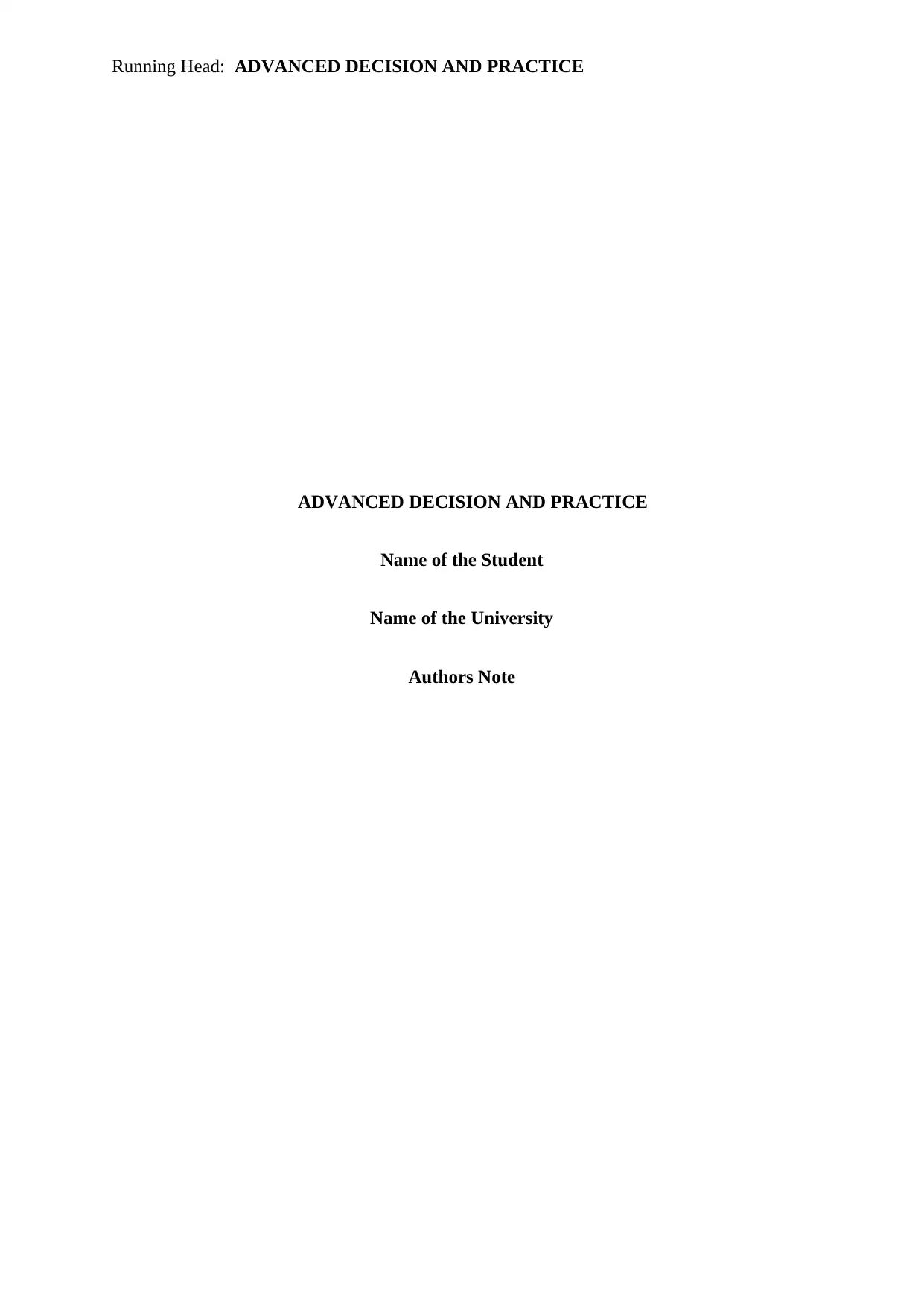
Running Head: ADVANCED DECISION AND PRACTICE
ADVANCED DECISION AND PRACTICE
Name of the Student
Name of the University
Authors Note
ADVANCED DECISION AND PRACTICE
Name of the Student
Name of the University
Authors Note
Paraphrase This Document
Need a fresh take? Get an instant paraphrase of this document with our AI Paraphraser
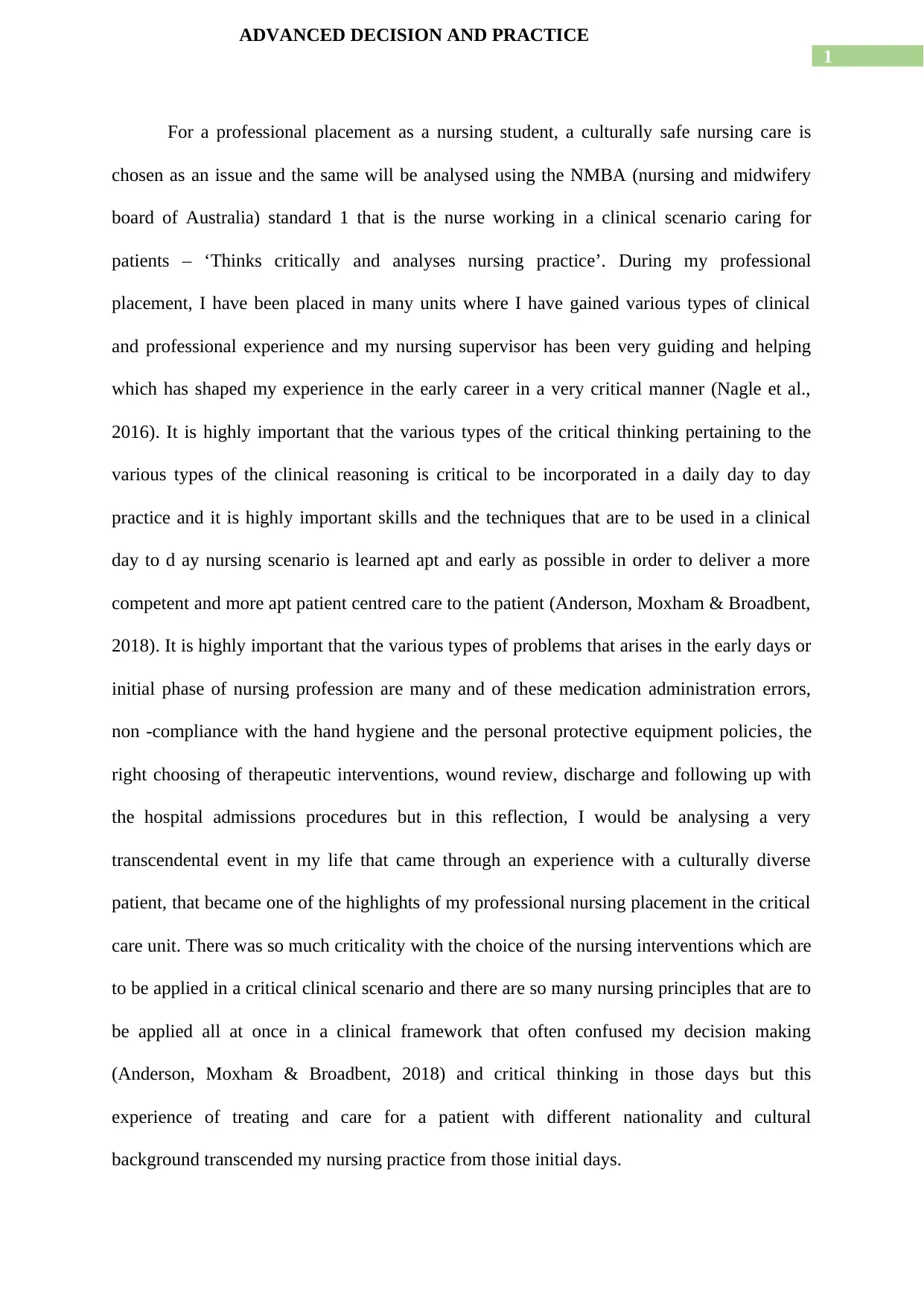
1
ADVANCED DECISION AND PRACTICE
For a professional placement as a nursing student, a culturally safe nursing care is
chosen as an issue and the same will be analysed using the NMBA (nursing and midwifery
board of Australia) standard 1 that is the nurse working in a clinical scenario caring for
patients – ‘Thinks critically and analyses nursing practice’. During my professional
placement, I have been placed in many units where I have gained various types of clinical
and professional experience and my nursing supervisor has been very guiding and helping
which has shaped my experience in the early career in a very critical manner (Nagle et al.,
2016). It is highly important that the various types of the critical thinking pertaining to the
various types of the clinical reasoning is critical to be incorporated in a daily day to day
practice and it is highly important skills and the techniques that are to be used in a clinical
day to d ay nursing scenario is learned apt and early as possible in order to deliver a more
competent and more apt patient centred care to the patient (Anderson, Moxham & Broadbent,
2018). It is highly important that the various types of problems that arises in the early days or
initial phase of nursing profession are many and of these medication administration errors,
non -compliance with the hand hygiene and the personal protective equipment policies, the
right choosing of therapeutic interventions, wound review, discharge and following up with
the hospital admissions procedures but in this reflection, I would be analysing a very
transcendental event in my life that came through an experience with a culturally diverse
patient, that became one of the highlights of my professional nursing placement in the critical
care unit. There was so much criticality with the choice of the nursing interventions which are
to be applied in a critical clinical scenario and there are so many nursing principles that are to
be applied all at once in a clinical framework that often confused my decision making
(Anderson, Moxham & Broadbent, 2018) and critical thinking in those days but this
experience of treating and care for a patient with different nationality and cultural
background transcended my nursing practice from those initial days.
ADVANCED DECISION AND PRACTICE
For a professional placement as a nursing student, a culturally safe nursing care is
chosen as an issue and the same will be analysed using the NMBA (nursing and midwifery
board of Australia) standard 1 that is the nurse working in a clinical scenario caring for
patients – ‘Thinks critically and analyses nursing practice’. During my professional
placement, I have been placed in many units where I have gained various types of clinical
and professional experience and my nursing supervisor has been very guiding and helping
which has shaped my experience in the early career in a very critical manner (Nagle et al.,
2016). It is highly important that the various types of the critical thinking pertaining to the
various types of the clinical reasoning is critical to be incorporated in a daily day to day
practice and it is highly important skills and the techniques that are to be used in a clinical
day to d ay nursing scenario is learned apt and early as possible in order to deliver a more
competent and more apt patient centred care to the patient (Anderson, Moxham & Broadbent,
2018). It is highly important that the various types of problems that arises in the early days or
initial phase of nursing profession are many and of these medication administration errors,
non -compliance with the hand hygiene and the personal protective equipment policies, the
right choosing of therapeutic interventions, wound review, discharge and following up with
the hospital admissions procedures but in this reflection, I would be analysing a very
transcendental event in my life that came through an experience with a culturally diverse
patient, that became one of the highlights of my professional nursing placement in the critical
care unit. There was so much criticality with the choice of the nursing interventions which are
to be applied in a critical clinical scenario and there are so many nursing principles that are to
be applied all at once in a clinical framework that often confused my decision making
(Anderson, Moxham & Broadbent, 2018) and critical thinking in those days but this
experience of treating and care for a patient with different nationality and cultural
background transcended my nursing practice from those initial days.
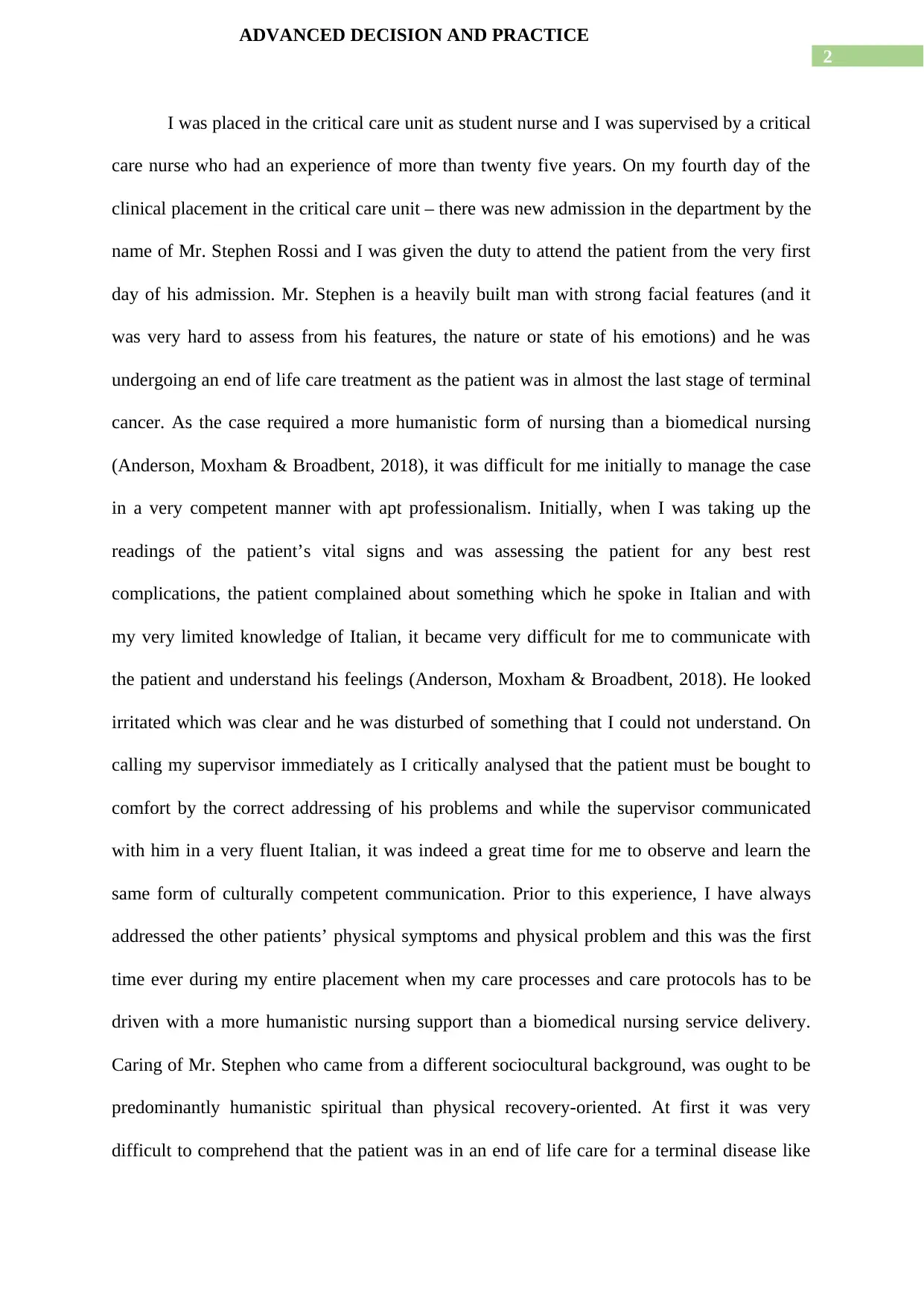
2
ADVANCED DECISION AND PRACTICE
I was placed in the critical care unit as student nurse and I was supervised by a critical
care nurse who had an experience of more than twenty five years. On my fourth day of the
clinical placement in the critical care unit – there was new admission in the department by the
name of Mr. Stephen Rossi and I was given the duty to attend the patient from the very first
day of his admission. Mr. Stephen is a heavily built man with strong facial features (and it
was very hard to assess from his features, the nature or state of his emotions) and he was
undergoing an end of life care treatment as the patient was in almost the last stage of terminal
cancer. As the case required a more humanistic form of nursing than a biomedical nursing
(Anderson, Moxham & Broadbent, 2018), it was difficult for me initially to manage the case
in a very competent manner with apt professionalism. Initially, when I was taking up the
readings of the patient’s vital signs and was assessing the patient for any best rest
complications, the patient complained about something which he spoke in Italian and with
my very limited knowledge of Italian, it became very difficult for me to communicate with
the patient and understand his feelings (Anderson, Moxham & Broadbent, 2018). He looked
irritated which was clear and he was disturbed of something that I could not understand. On
calling my supervisor immediately as I critically analysed that the patient must be bought to
comfort by the correct addressing of his problems and while the supervisor communicated
with him in a very fluent Italian, it was indeed a great time for me to observe and learn the
same form of culturally competent communication. Prior to this experience, I have always
addressed the other patients’ physical symptoms and physical problem and this was the first
time ever during my entire placement when my care processes and care protocols has to be
driven with a more humanistic nursing support than a biomedical nursing service delivery.
Caring of Mr. Stephen who came from a different sociocultural background, was ought to be
predominantly humanistic spiritual than physical recovery-oriented. At first it was very
difficult to comprehend that the patient was in an end of life care for a terminal disease like
ADVANCED DECISION AND PRACTICE
I was placed in the critical care unit as student nurse and I was supervised by a critical
care nurse who had an experience of more than twenty five years. On my fourth day of the
clinical placement in the critical care unit – there was new admission in the department by the
name of Mr. Stephen Rossi and I was given the duty to attend the patient from the very first
day of his admission. Mr. Stephen is a heavily built man with strong facial features (and it
was very hard to assess from his features, the nature or state of his emotions) and he was
undergoing an end of life care treatment as the patient was in almost the last stage of terminal
cancer. As the case required a more humanistic form of nursing than a biomedical nursing
(Anderson, Moxham & Broadbent, 2018), it was difficult for me initially to manage the case
in a very competent manner with apt professionalism. Initially, when I was taking up the
readings of the patient’s vital signs and was assessing the patient for any best rest
complications, the patient complained about something which he spoke in Italian and with
my very limited knowledge of Italian, it became very difficult for me to communicate with
the patient and understand his feelings (Anderson, Moxham & Broadbent, 2018). He looked
irritated which was clear and he was disturbed of something that I could not understand. On
calling my supervisor immediately as I critically analysed that the patient must be bought to
comfort by the correct addressing of his problems and while the supervisor communicated
with him in a very fluent Italian, it was indeed a great time for me to observe and learn the
same form of culturally competent communication. Prior to this experience, I have always
addressed the other patients’ physical symptoms and physical problem and this was the first
time ever during my entire placement when my care processes and care protocols has to be
driven with a more humanistic nursing support than a biomedical nursing service delivery.
Caring of Mr. Stephen who came from a different sociocultural background, was ought to be
predominantly humanistic spiritual than physical recovery-oriented. At first it was very
difficult to comprehend that the patient was in an end of life care for a terminal disease like
⊘ This is a preview!⊘
Do you want full access?
Subscribe today to unlock all pages.

Trusted by 1+ million students worldwide

3
ADVANCED DECISION AND PRACTICE
cancer and he was not getting treated to be recovered (Ossenberg, Mitchell & Henderson,
2019). To understand, realize this and accept this, was the most critical aspect of the nursing
care given by me and it was difficult for me, more than anything, that he would be dying in
the end and the care process ‘end-of-life care’ is targeted at bettering the last limited days of
his life. It seriously took a lot of clinical reasoning and critical thinking to analyse the kind of
nursing practice that I was applying with Mr. Stephen Rossi. More than everything it took a
lot of emotional resilience to confront the patient during my regular day to day nursing
practice. The supervisor, I still remember, said to me that is worried about the phenomenon
known as "colpo d'aria", which got me surprised and she asked to research about the same
before I attend the patient next time and it was highly critical that I should also plan the care
process based on the same problem that is worrying the patient so much. That day, as asked
of me and to better my critical thinking and analytic skills – I researched about "colpo d'aria"
and found out that the Italians believe that the rapidly falling or changing temperatures in the
air cause ‘malady’ that is disease in the human body and they happen to believe this in a very
profound manner, almost to the level of fear caused by this superstition (Nguyen-Truong,
Closner & Fritz, 2019). I analysed immediately, that the patient was worried of the ‘bad air’
and I formulated a plan of care for the subject that was integrated within the framework of
end of life care. I applied my critical thinking skills to apply with nursing knowledge to
understand the social, physical, psychological and spiritual needs of the patient that are to be
addressed in the clinical framework. Doing and performing the nursing assessment, I found
out the physical needs of the patient that is, the patient had bed sores and rapid pressure
changes and the mentally, patient was suffering from anxiety and stress. Socially, he has a
good bond with his family – that is his wife and his son who comes to visit him every day
(Olukotun et al., 2018). The patient has been suffering from existential crisis. The plan of
care that I formulated included a pharmacological management (for blood pressure
ADVANCED DECISION AND PRACTICE
cancer and he was not getting treated to be recovered (Ossenberg, Mitchell & Henderson,
2019). To understand, realize this and accept this, was the most critical aspect of the nursing
care given by me and it was difficult for me, more than anything, that he would be dying in
the end and the care process ‘end-of-life care’ is targeted at bettering the last limited days of
his life. It seriously took a lot of clinical reasoning and critical thinking to analyse the kind of
nursing practice that I was applying with Mr. Stephen Rossi. More than everything it took a
lot of emotional resilience to confront the patient during my regular day to day nursing
practice. The supervisor, I still remember, said to me that is worried about the phenomenon
known as "colpo d'aria", which got me surprised and she asked to research about the same
before I attend the patient next time and it was highly critical that I should also plan the care
process based on the same problem that is worrying the patient so much. That day, as asked
of me and to better my critical thinking and analytic skills – I researched about "colpo d'aria"
and found out that the Italians believe that the rapidly falling or changing temperatures in the
air cause ‘malady’ that is disease in the human body and they happen to believe this in a very
profound manner, almost to the level of fear caused by this superstition (Nguyen-Truong,
Closner & Fritz, 2019). I analysed immediately, that the patient was worried of the ‘bad air’
and I formulated a plan of care for the subject that was integrated within the framework of
end of life care. I applied my critical thinking skills to apply with nursing knowledge to
understand the social, physical, psychological and spiritual needs of the patient that are to be
addressed in the clinical framework. Doing and performing the nursing assessment, I found
out the physical needs of the patient that is, the patient had bed sores and rapid pressure
changes and the mentally, patient was suffering from anxiety and stress. Socially, he has a
good bond with his family – that is his wife and his son who comes to visit him every day
(Olukotun et al., 2018). The patient has been suffering from existential crisis. The plan of
care that I formulated included a pharmacological management (for blood pressure
Paraphrase This Document
Need a fresh take? Get an instant paraphrase of this document with our AI Paraphraser
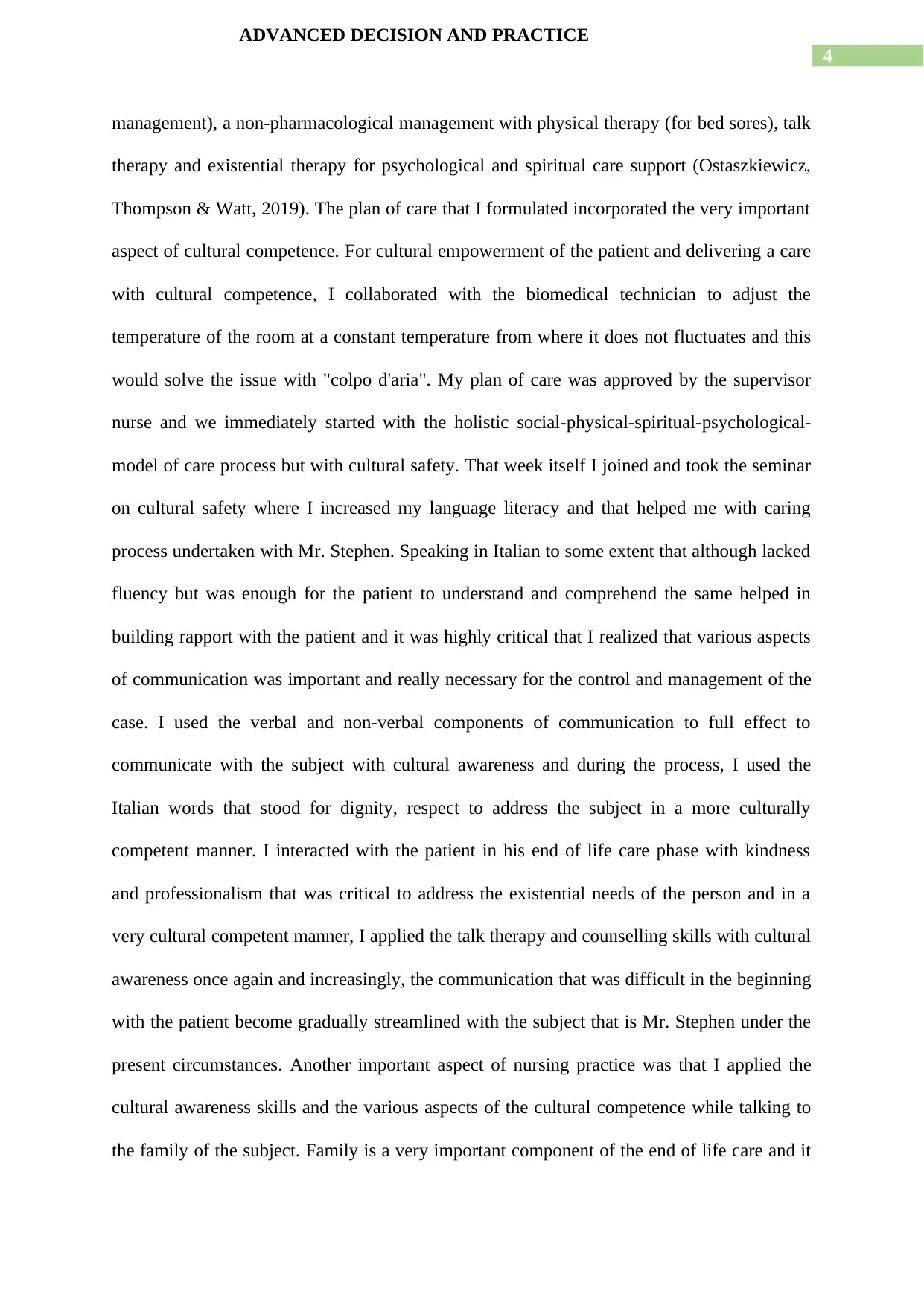
4
ADVANCED DECISION AND PRACTICE
management), a non-pharmacological management with physical therapy (for bed sores), talk
therapy and existential therapy for psychological and spiritual care support (Ostaszkiewicz,
Thompson & Watt, 2019). The plan of care that I formulated incorporated the very important
aspect of cultural competence. For cultural empowerment of the patient and delivering a care
with cultural competence, I collaborated with the biomedical technician to adjust the
temperature of the room at a constant temperature from where it does not fluctuates and this
would solve the issue with "colpo d'aria". My plan of care was approved by the supervisor
nurse and we immediately started with the holistic social-physical-spiritual-psychological-
model of care process but with cultural safety. That week itself I joined and took the seminar
on cultural safety where I increased my language literacy and that helped me with caring
process undertaken with Mr. Stephen. Speaking in Italian to some extent that although lacked
fluency but was enough for the patient to understand and comprehend the same helped in
building rapport with the patient and it was highly critical that I realized that various aspects
of communication was important and really necessary for the control and management of the
case. I used the verbal and non-verbal components of communication to full effect to
communicate with the subject with cultural awareness and during the process, I used the
Italian words that stood for dignity, respect to address the subject in a more culturally
competent manner. I interacted with the patient in his end of life care phase with kindness
and professionalism that was critical to address the existential needs of the person and in a
very cultural competent manner, I applied the talk therapy and counselling skills with cultural
awareness once again and increasingly, the communication that was difficult in the beginning
with the patient become gradually streamlined with the subject that is Mr. Stephen under the
present circumstances. Another important aspect of nursing practice was that I applied the
cultural awareness skills and the various aspects of the cultural competence while talking to
the family of the subject. Family is a very important component of the end of life care and it
ADVANCED DECISION AND PRACTICE
management), a non-pharmacological management with physical therapy (for bed sores), talk
therapy and existential therapy for psychological and spiritual care support (Ostaszkiewicz,
Thompson & Watt, 2019). The plan of care that I formulated incorporated the very important
aspect of cultural competence. For cultural empowerment of the patient and delivering a care
with cultural competence, I collaborated with the biomedical technician to adjust the
temperature of the room at a constant temperature from where it does not fluctuates and this
would solve the issue with "colpo d'aria". My plan of care was approved by the supervisor
nurse and we immediately started with the holistic social-physical-spiritual-psychological-
model of care process but with cultural safety. That week itself I joined and took the seminar
on cultural safety where I increased my language literacy and that helped me with caring
process undertaken with Mr. Stephen. Speaking in Italian to some extent that although lacked
fluency but was enough for the patient to understand and comprehend the same helped in
building rapport with the patient and it was highly critical that I realized that various aspects
of communication was important and really necessary for the control and management of the
case. I used the verbal and non-verbal components of communication to full effect to
communicate with the subject with cultural awareness and during the process, I used the
Italian words that stood for dignity, respect to address the subject in a more culturally
competent manner. I interacted with the patient in his end of life care phase with kindness
and professionalism that was critical to address the existential needs of the person and in a
very cultural competent manner, I applied the talk therapy and counselling skills with cultural
awareness once again and increasingly, the communication that was difficult in the beginning
with the patient become gradually streamlined with the subject that is Mr. Stephen under the
present circumstances. Another important aspect of nursing practice was that I applied the
cultural awareness skills and the various aspects of the cultural competence while talking to
the family of the subject. Family is a very important component of the end of life care and it
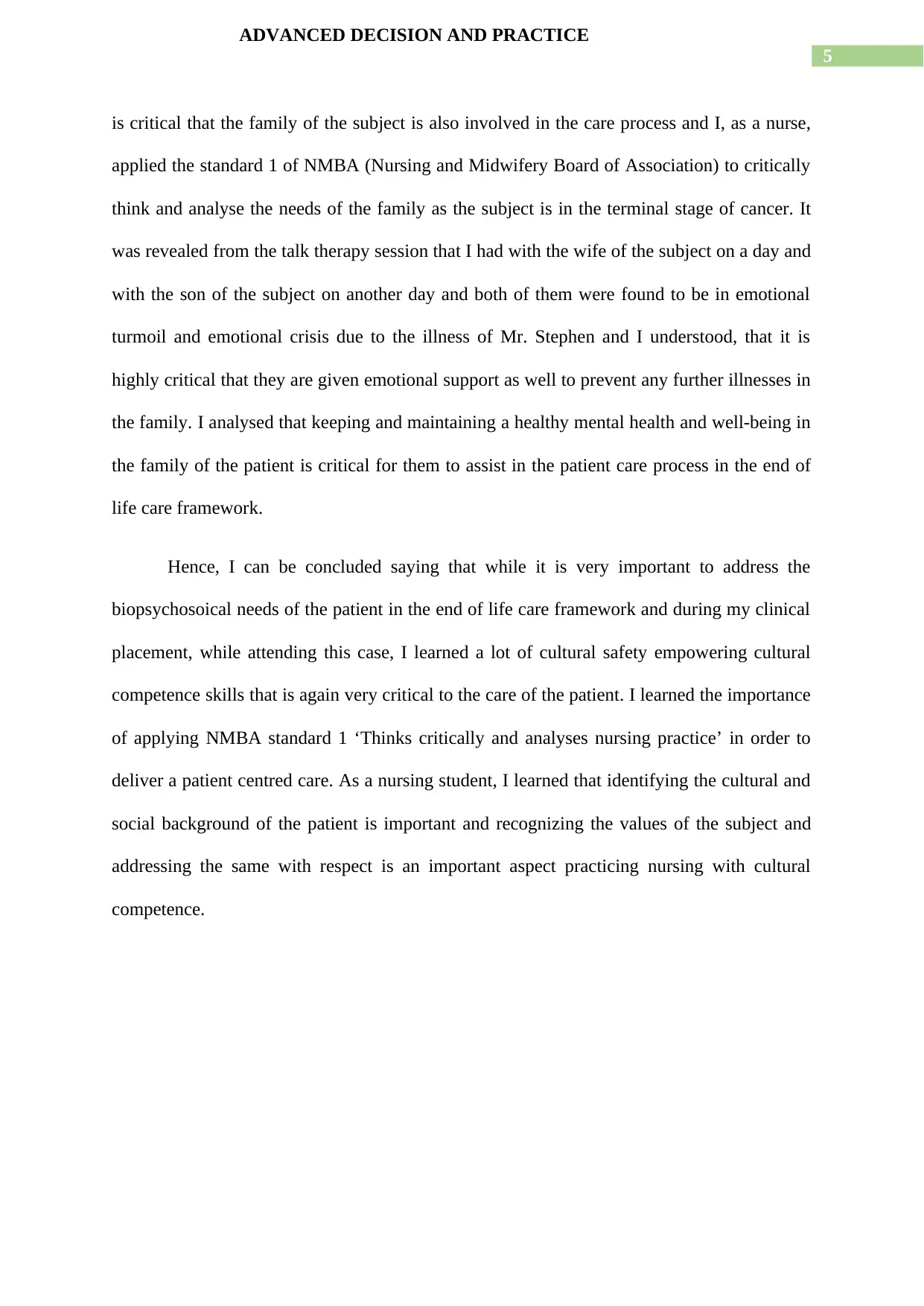
5
ADVANCED DECISION AND PRACTICE
is critical that the family of the subject is also involved in the care process and I, as a nurse,
applied the standard 1 of NMBA (Nursing and Midwifery Board of Association) to critically
think and analyse the needs of the family as the subject is in the terminal stage of cancer. It
was revealed from the talk therapy session that I had with the wife of the subject on a day and
with the son of the subject on another day and both of them were found to be in emotional
turmoil and emotional crisis due to the illness of Mr. Stephen and I understood, that it is
highly critical that they are given emotional support as well to prevent any further illnesses in
the family. I analysed that keeping and maintaining a healthy mental health and well-being in
the family of the patient is critical for them to assist in the patient care process in the end of
life care framework.
Hence, I can be concluded saying that while it is very important to address the
biopsychosoical needs of the patient in the end of life care framework and during my clinical
placement, while attending this case, I learned a lot of cultural safety empowering cultural
competence skills that is again very critical to the care of the patient. I learned the importance
of applying NMBA standard 1 ‘Thinks critically and analyses nursing practice’ in order to
deliver a patient centred care. As a nursing student, I learned that identifying the cultural and
social background of the patient is important and recognizing the values of the subject and
addressing the same with respect is an important aspect practicing nursing with cultural
competence.
ADVANCED DECISION AND PRACTICE
is critical that the family of the subject is also involved in the care process and I, as a nurse,
applied the standard 1 of NMBA (Nursing and Midwifery Board of Association) to critically
think and analyse the needs of the family as the subject is in the terminal stage of cancer. It
was revealed from the talk therapy session that I had with the wife of the subject on a day and
with the son of the subject on another day and both of them were found to be in emotional
turmoil and emotional crisis due to the illness of Mr. Stephen and I understood, that it is
highly critical that they are given emotional support as well to prevent any further illnesses in
the family. I analysed that keeping and maintaining a healthy mental health and well-being in
the family of the patient is critical for them to assist in the patient care process in the end of
life care framework.
Hence, I can be concluded saying that while it is very important to address the
biopsychosoical needs of the patient in the end of life care framework and during my clinical
placement, while attending this case, I learned a lot of cultural safety empowering cultural
competence skills that is again very critical to the care of the patient. I learned the importance
of applying NMBA standard 1 ‘Thinks critically and analyses nursing practice’ in order to
deliver a patient centred care. As a nursing student, I learned that identifying the cultural and
social background of the patient is important and recognizing the values of the subject and
addressing the same with respect is an important aspect practicing nursing with cultural
competence.
⊘ This is a preview!⊘
Do you want full access?
Subscribe today to unlock all pages.

Trusted by 1+ million students worldwide
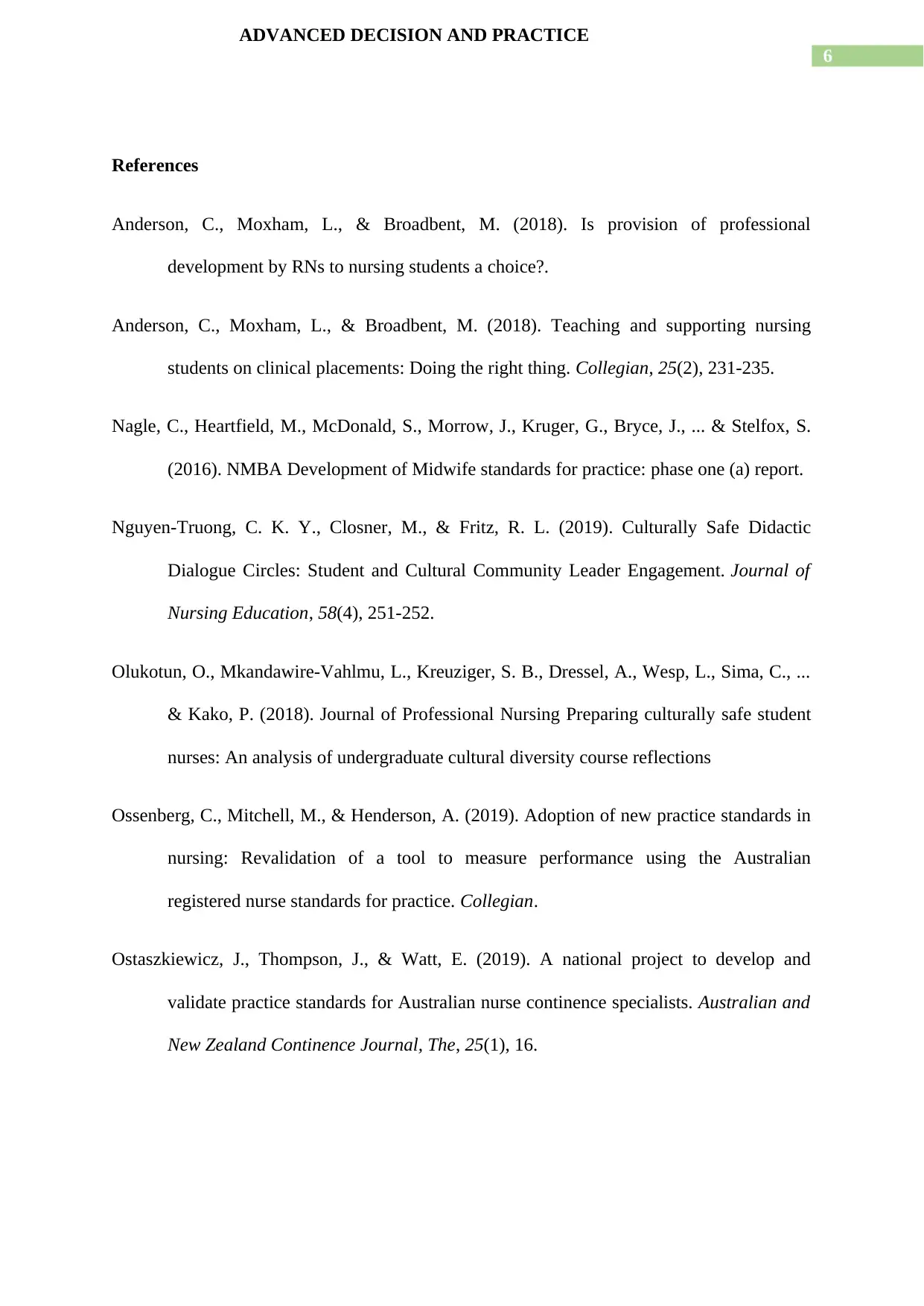
6
ADVANCED DECISION AND PRACTICE
References
Anderson, C., Moxham, L., & Broadbent, M. (2018). Is provision of professional
development by RNs to nursing students a choice?.
Anderson, C., Moxham, L., & Broadbent, M. (2018). Teaching and supporting nursing
students on clinical placements: Doing the right thing. Collegian, 25(2), 231-235.
Nagle, C., Heartfield, M., McDonald, S., Morrow, J., Kruger, G., Bryce, J., ... & Stelfox, S.
(2016). NMBA Development of Midwife standards for practice: phase one (a) report.
Nguyen-Truong, C. K. Y., Closner, M., & Fritz, R. L. (2019). Culturally Safe Didactic
Dialogue Circles: Student and Cultural Community Leader Engagement. Journal of
Nursing Education, 58(4), 251-252.
Olukotun, O., Mkandawire-Vahlmu, L., Kreuziger, S. B., Dressel, A., Wesp, L., Sima, C., ...
& Kako, P. (2018). Journal of Professional Nursing Preparing culturally safe student
nurses: An analysis of undergraduate cultural diversity course reflections
Ossenberg, C., Mitchell, M., & Henderson, A. (2019). Adoption of new practice standards in
nursing: Revalidation of a tool to measure performance using the Australian
registered nurse standards for practice. Collegian.
Ostaszkiewicz, J., Thompson, J., & Watt, E. (2019). A national project to develop and
validate practice standards for Australian nurse continence specialists. Australian and
New Zealand Continence Journal, The, 25(1), 16.
ADVANCED DECISION AND PRACTICE
References
Anderson, C., Moxham, L., & Broadbent, M. (2018). Is provision of professional
development by RNs to nursing students a choice?.
Anderson, C., Moxham, L., & Broadbent, M. (2018). Teaching and supporting nursing
students on clinical placements: Doing the right thing. Collegian, 25(2), 231-235.
Nagle, C., Heartfield, M., McDonald, S., Morrow, J., Kruger, G., Bryce, J., ... & Stelfox, S.
(2016). NMBA Development of Midwife standards for practice: phase one (a) report.
Nguyen-Truong, C. K. Y., Closner, M., & Fritz, R. L. (2019). Culturally Safe Didactic
Dialogue Circles: Student and Cultural Community Leader Engagement. Journal of
Nursing Education, 58(4), 251-252.
Olukotun, O., Mkandawire-Vahlmu, L., Kreuziger, S. B., Dressel, A., Wesp, L., Sima, C., ...
& Kako, P. (2018). Journal of Professional Nursing Preparing culturally safe student
nurses: An analysis of undergraduate cultural diversity course reflections
Ossenberg, C., Mitchell, M., & Henderson, A. (2019). Adoption of new practice standards in
nursing: Revalidation of a tool to measure performance using the Australian
registered nurse standards for practice. Collegian.
Ostaszkiewicz, J., Thompson, J., & Watt, E. (2019). A national project to develop and
validate practice standards for Australian nurse continence specialists. Australian and
New Zealand Continence Journal, The, 25(1), 16.
Paraphrase This Document
Need a fresh take? Get an instant paraphrase of this document with our AI Paraphraser
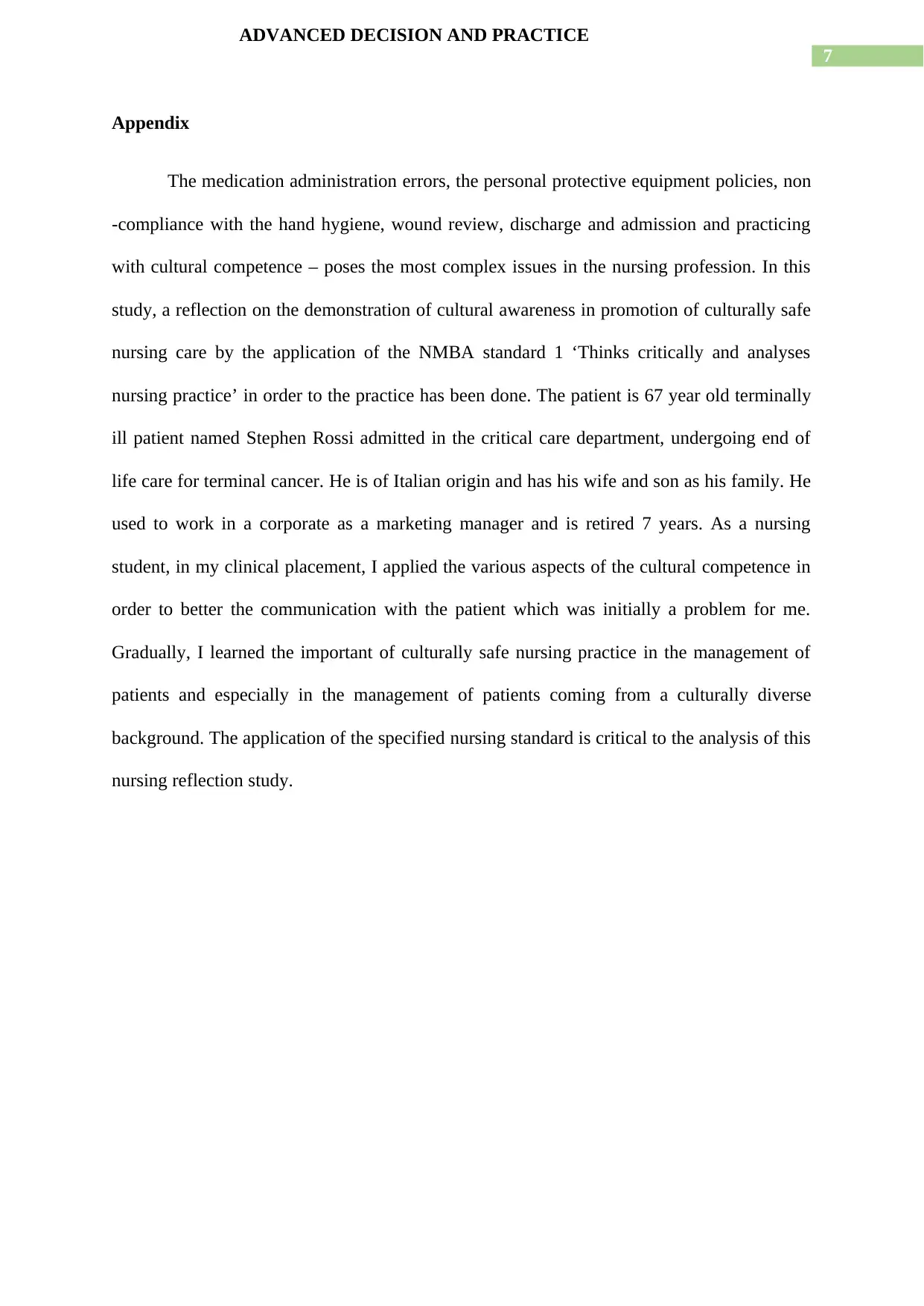
7
ADVANCED DECISION AND PRACTICE
Appendix
The medication administration errors, the personal protective equipment policies, non
-compliance with the hand hygiene, wound review, discharge and admission and practicing
with cultural competence – poses the most complex issues in the nursing profession. In this
study, a reflection on the demonstration of cultural awareness in promotion of culturally safe
nursing care by the application of the NMBA standard 1 ‘Thinks critically and analyses
nursing practice’ in order to the practice has been done. The patient is 67 year old terminally
ill patient named Stephen Rossi admitted in the critical care department, undergoing end of
life care for terminal cancer. He is of Italian origin and has his wife and son as his family. He
used to work in a corporate as a marketing manager and is retired 7 years. As a nursing
student, in my clinical placement, I applied the various aspects of the cultural competence in
order to better the communication with the patient which was initially a problem for me.
Gradually, I learned the important of culturally safe nursing practice in the management of
patients and especially in the management of patients coming from a culturally diverse
background. The application of the specified nursing standard is critical to the analysis of this
nursing reflection study.
ADVANCED DECISION AND PRACTICE
Appendix
The medication administration errors, the personal protective equipment policies, non
-compliance with the hand hygiene, wound review, discharge and admission and practicing
with cultural competence – poses the most complex issues in the nursing profession. In this
study, a reflection on the demonstration of cultural awareness in promotion of culturally safe
nursing care by the application of the NMBA standard 1 ‘Thinks critically and analyses
nursing practice’ in order to the practice has been done. The patient is 67 year old terminally
ill patient named Stephen Rossi admitted in the critical care department, undergoing end of
life care for terminal cancer. He is of Italian origin and has his wife and son as his family. He
used to work in a corporate as a marketing manager and is retired 7 years. As a nursing
student, in my clinical placement, I applied the various aspects of the cultural competence in
order to better the communication with the patient which was initially a problem for me.
Gradually, I learned the important of culturally safe nursing practice in the management of
patients and especially in the management of patients coming from a culturally diverse
background. The application of the specified nursing standard is critical to the analysis of this
nursing reflection study.
1 out of 8
Related Documents
Your All-in-One AI-Powered Toolkit for Academic Success.
+13062052269
info@desklib.com
Available 24*7 on WhatsApp / Email
![[object Object]](/_next/static/media/star-bottom.7253800d.svg)
Unlock your academic potential
© 2024 | Zucol Services PVT LTD | All rights reserved.





